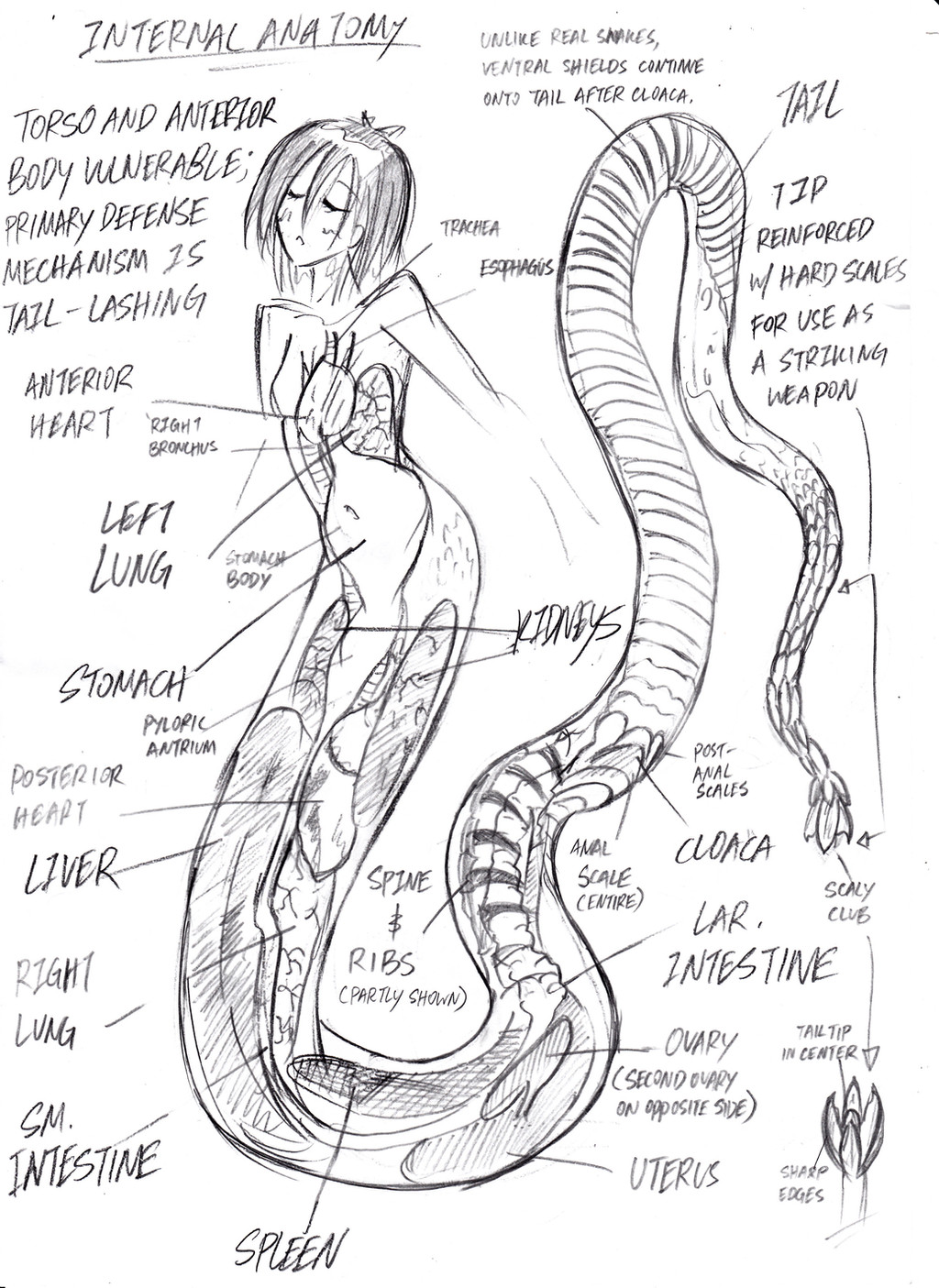HOME | DD
 TheSsssFactor — Eve's Insides v2.0
TheSsssFactor — Eve's Insides v2.0

Published: 2013-10-08 15:36:52 +0000 UTC; Views: 2379; Favourites: 33; Downloads: 23
Redirect to original
Description
After some thought and a chat with I decided to upload this messier version of pretty much the same thing ;v;Primary differences are:
-TWO hearts; the first is located in the chest cavity while the second heart is located close to the ‘join’ between human and snake bodies. The anterior heart is responsible for most of the blood circulation to the upper torso, drawing most of its oxygen from the left lung which shares the upper body, while the much larger second heart circulates blood through the correspondingly larger lower body, with the huge right lung serving as its primary source of oxygenated blood. It can be said that the naga have the heart of a human, but also the heart of a snake.
-Tail: To facilitate use of the tail as an effective striking weapon, the scales on the tail are large and hard, providing strength at the cost of some flexibility. Four scales at the tail's very tip are flanged outwards and have sharp outer cutting edges, similar in principle to some variations of medieval maces. These provide wounding ability in addition to the blunt trauma caused by the lashing tail. The muscles that drive the tail in combat are remarkably strong and the end of the tail can reach an impact velocity in excess of 60 miles per hour when swung at full force.
Plus little details on the existing things~~
Related content
Comments: 57

But for cold blooded, the disadvantage is that you can't just go anywhere. If you go to a cold climate, you'll freeze because you wouldn't be able to maintain your body's temperature independently of the environment.
But still, something as big as a goat, still seems really hard to digest and yah. So wouldn't that mean that the snake would spend all year eating 1 big animal every now and then and then just go to sleep for the rest of the time?
👍: 0 ⏩: 1

Exactly. That's why you get the most reptiles in tropical areas. That said, there is one snake that lives north of the Arctic circle and can tolerate exceedingly low temperatures, the Adder of Europe and the British Isles. I went on a field survey for these snakes as part of my course last year and the windchill factor in the area where we looked for them was -9. It even snowed in the night. These snakes were going about their business like there was no problem and I was wrapped up in three layers of sweaters and freezing! It's all about adaptation, I feel. Life is magic! 
You're pretty much right. The big snakes do that, the small snakes eat more often.
👍: 0 ⏩: 1

But at -9 degrees how are they suppose to keep warm? Cause being cold blooded, wouldn't that mean that their internal temperature would also be -9 so bodily processes cannot occur?
Or are they like those thermophilic bacteria that can survive at 90+ degrees?
👍: 0 ⏩: 1

Well, they aren't particularly big snakes, so they can make most use of the low-to-ground plant cover to keep them out of the worst of the wind. They come out in the mornings to bask in the sun whenever possible. They make use of the heat absorbed by the ground to warm up. They are dark in color to absorb as much heat as possible. Also they have high levels of glucose in their bloodstream which acts as an anti-freeze. "Cold-blooded" doesn't necessarily mean you are exactly the same temperature as your immediate surroundings - there is a lot an animal can do to maintain its body heat. Adders are the most extreme example in the reptile world, but there are also turtles and alligators in North America which live in very cold swamp water, and use many of the same tricks to survive.
👍: 0 ⏩: 0

Ah.
Well, it still sounds quite deadly
👍: 0 ⏩: 1
<= Prev |
























